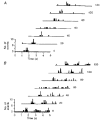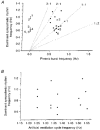Focally recorded single sympathetic postganglionic neuronal activity supplying rat lateral tail vein
- PMID: 9508818
- PMCID: PMC2230877
- DOI: 10.1111/j.1469-7793.1998.575bq.x
Focally recorded single sympathetic postganglionic neuronal activity supplying rat lateral tail vein
Abstract
1. In anaesthetized rats, using a focal recording technique, activity was recorded from single sympathetic postganglionic neurones innervating the lateral tail veins. On-going activity was examined in order to determine whether it had similar or different characteristics to those recorded from the caudal ventral artery in a previous study. 2. Animals were artificially ventilated, vagotomized, paralysed and given a pneumothorax. 3. The discharges of fourteen out of seventeen sympathetic postganglionic neurones were rhythmic. Such units had a mean firing frequency of 1.62 +/- 0. 70 Hz. The mean frequency of the dominant sympathetic rhythm under control conditions was 0.82 +/- 0.05 Hz. 4. The frequency of the dominant sympathetic rhythm was different from that of the phrenic rhythm in nine out of fourteen cases. 5. The mean frequency of the dominant sympathetic rhythm was: (i) not influenced significantly by hypocapnic apnoea, (ii) decreased by hyperthermia, which increased the frequency of the phrenic rhythm, (iii) in all cases different from that of the artificial ventilation cycle. 6. The above characteristics are similar to those recorded from the sympathetic supply to the caudal ventral artery of the same vascular bed under comparable conditions.
Figures







Similar articles
-
On the dominant rhythm in the discharges of single postganglionic sympathetic neurones innervating the rat tail artery.J Physiol. 1996 Nov 15;497 ( Pt 1)(Pt 1):241-59. doi: 10.1113/jphysiol.1996.sp021764. J Physiol. 1996. PMID: 8951726 Free PMC article.
-
Rhythmicity in single fiber postganglionic activity supplying the rat tail.J Neurophysiol. 1999 May;81(5):2026-36. doi: 10.1152/jn.1999.81.5.2026. J Neurophysiol. 1999. PMID: 10322044
-
Coherent rhythmic discharges in sympathetic nerves supplying thermoregulatory circulations in the rat.J Physiol. 2000 Mar 1;523 Pt 2(Pt 2):449-57. doi: 10.1111/j.1469-7793.2000.00449.x. J Physiol. 2000. PMID: 10699088 Free PMC article.
-
Multiple oscillators, dynamic synchronization and sympathetic control.Clin Exp Pharmacol Physiol. 2001 Jan-Feb;28(1-2):130-7. doi: 10.1046/j.1440-1681.2001.03414.x. Clin Exp Pharmacol Physiol. 2001. PMID: 11153530 Review.
-
Firing properties of single postganglionic sympathetic neurones recorded in awake human subjects.Auton Neurosci. 2002 Jan 10;95(1-2):146-59. doi: 10.1016/s1566-0702(01)00389-7. Auton Neurosci. 2002. PMID: 11871781 Review.
Cited by
-
Multiple thermoregulatory effectors with independent central controls.Eur J Appl Physiol. 2010 May;109(1):27-33. doi: 10.1007/s00421-009-1295-z. Epub 2009 Dec 1. Eur J Appl Physiol. 2010. PMID: 19949811 Review.
-
Thermoregulatory control of sympathetic fibres supplying the rat's tail.J Physiol. 2002 Sep 15;543(Pt 3):849-58. doi: 10.1113/jphysiol.2002.023770. J Physiol. 2002. PMID: 12231643 Free PMC article.
-
ATP overflow in skeletal muscle 1A arterioles.J Physiol. 2010 Aug 15;588(Pt 16):3089-100. doi: 10.1113/jphysiol.2010.193094. Epub 2010 Jun 21. J Physiol. 2010. PMID: 20566660 Free PMC article.
-
Medullary raphe neurons facilitate brown adipose tissue activation.J Neurosci. 2006 Jan 25;26(4):1190-8. doi: 10.1523/JNEUROSCI.4707-05.2006. J Neurosci. 2006. PMID: 16436606 Free PMC article.
-
Entanglement between thermoregulation and nociception in the rat: the case of morphine.J Neurophysiol. 2016 Dec 1;116(6):2473-2496. doi: 10.1152/jn.00482.2016. Epub 2016 Sep 7. J Neurophysiol. 2016. PMID: 27605533 Free PMC article.
References
-
- Andrews T J. PhD Thesis. University of London; 1993. The role of targets and growth factors in neuronal ageing.
-
- Aukland K, Wiig H. Haemodynamics and interstitial fluid pressure in the rat tail. American Journal of Physiology. 1984;247:H80–87. - PubMed
-
- Bevan J A, Bevan R D, Duckles S P. Adrenergic regulation of smooth muscle. In: Shepherd J T, Abboud F M, editors. Handbook of Physiology, section 2, The Cardiovascular System. III. Bethesda, MD, USA: American Physiological Society; 1986. pp. 515–566. part 1.
-
- Dehal N S, Kartseva A G, Weaver L C. Comparisons of locations and peptide content of postganglionic nerves innervating veins and arteries of the rat hindlimb. Journal of the Autonomic Nervous System. 1992;39:61–72. 10.1016/0165-1838(92)90251-B. - DOI - PubMed
Publication types
MeSH terms
Substances
Grants and funding
LinkOut - more resources
Full Text Sources

